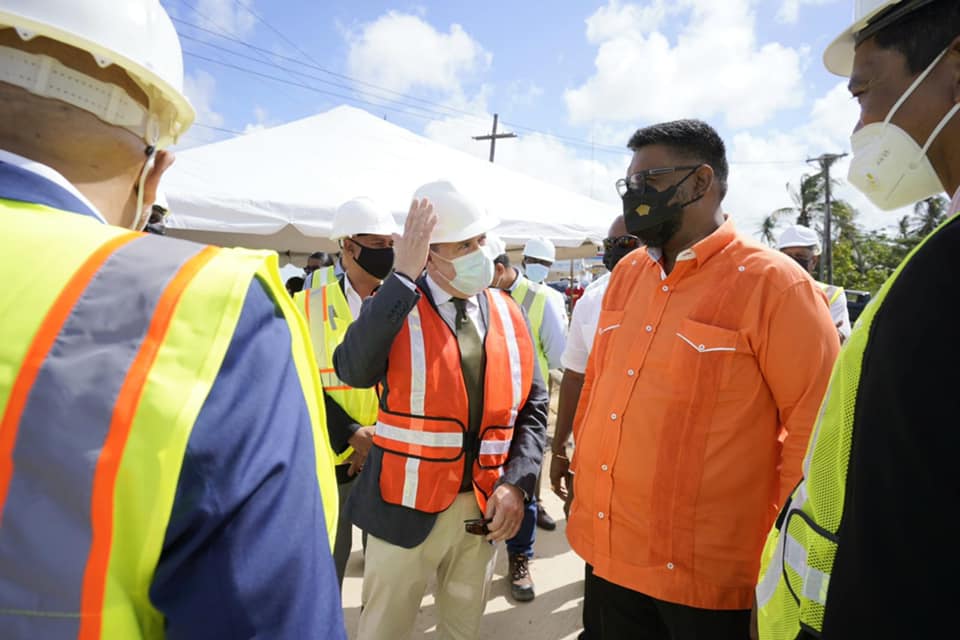Guyana’s President, Dr Mohamed Irfaan Ali, on Friday paid a visit to CGX’s Deep Water Port site at Palmyra, Berbice where it was highlighted that the construction and operational phase of this US$80 million investment will create more than 1,000 jobs.
In fact, complete construction of the port will result in no less than 1000 jobs being created, and when fully operational, the port would create more than 350 jobs and translate to millions of US dollars in investment for Berbice. The civil works are being carried out by CGX Energy Inc.’s subsidiary— Grand Canal Industrial Estates Inc. (GCIE).
This deep-water port will enable provisions of operators and vendors operating in both territorial waters of Guyana and Suriname. The construction continues on schedule; active construction ongoing on the access road (62% completed); bridge from Corentyne Highway (85% completed) complete; rip-rap flood protection (94% completed); extension of electricity infrastructure to port site (85% completed); extension of water infrastructure to the port site (39% completed) and quayside lay-down yard, (31% completed). All permits and permissions are in place.
On Friday, President Ali was joined by Senior Minister within the Office of the President with responsibility for Finance, Dr Ashni Singh and Minister within the Ministry of Public Works, Deodat Indar. Canadian Ambassador to Guyana, Mark Berman has also accompanied the President.
Before inspecting the Berbice Deep Water Port site, President Ali commissioned the newly constructed seawall access bridge in Palmyra.
Following his visit to the deep-water port, Mr. Ali today revealed that the Port Mourant Training Centre would be transformed into the country’s National Oil and Gas Institute.
He reminisced on the quality of the craftsmen that the centre has produced throughout the years, many of whom excelled outside of Guyana. With its drive for excellence, he indicated that it would be the perfect location to have the transformation area of study.
Mr. Ali said that high on the agenda of his government is to transparently design Guyana’s future so that it will deliver prosperity for the next generation while ensuring that the framework is created so that the current generation can enjoy the benefits of Guyana’s economic potential and continuous growth.
“The objective of the plan for this region and a national strategy is to build sustainable communities,” he said.
Mr. Ali pointed out that there is also a need to reduce the disparity between the rich and the ‘not so rich’ and between genders. These fundamental elements of sustainable development will be added to the national and regional plans to ensure an across-the-board implementation.
“If we have a deep-water harbour in Region Six that is linked to Suriname and linked to other opportunities, the infrastructure must be in place to take care of this. You must have wider roads; you must have better highways, and most people do not understand that Region Six has the important catalytic push to bring what we call trans-border development,” the President explained.
He said that very soon, the project to expand the highway closer to international standards will be launched and will represent an investment of more than US$100 million.
Furthermore, he also reminded that in January, there would be a summit between Guyana, Brazil, Suriname, and France—who has requested to join—to discuss the creation of an energy hub. With cheaper power and the largest A-grade bauxite that lies in Region Six, the Guyanese leader highlighted that it is economically viable to create a smelter.
“A smelter that leads to an aluminum plant leads to constant work and a justification for a deep-water port that will be of the size and magnitude we can’t even imagine,” he said.
Notably, the Offshore Supply Base portion of CGX’s port is expected to be fully operational in Q3, 2022, with the Multi-Purpose Terminal, servicing agricultural, general, and containerized cargos being fully operational at the end of Q4, 2023.



